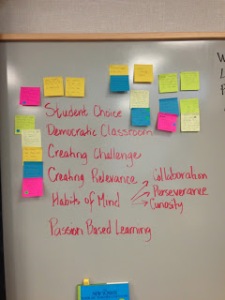 I feel I am back on my EdJourney, but this time I did not have to get in my Prius and drive around the country. This time I sat at my kitchen table and talked for an hour about how a public school district is moving on the innovation pathway just as effectively and swiftly as any school I visited last fall. They feel they are “out on a limb”, that “everyone probably thinks we are crazy.” Well, they are testing some important limbs and they sure are not crazy. How are they doing it? Read on!
I feel I am back on my EdJourney, but this time I did not have to get in my Prius and drive around the country. This time I sat at my kitchen table and talked for an hour about how a public school district is moving on the innovation pathway just as effectively and swiftly as any school I visited last fall. They feel they are “out on a limb”, that “everyone probably thinks we are crazy.” Well, they are testing some important limbs and they sure are not crazy. How are they doing it? Read on!
Alyssa Gallagher (@am_gallagher) has a new title this year: Director of Strategic Initiatives and Community Partnerships. (Once again, I ask: do you have someone in your school or district with a title like that, and if not, who is responsible for actually ensuring innovation takes root?) Los Altos School District is a K-8 with 4,500 student and nine schools. They are in the heart of Silicon Valley so they have a fairly affluent, knowledgeable parent base, but up until a few years ago, Alyssa says they were completely traditional. With a raft of new leadership in 2010, they asked themselves what so many of us are asking: “can’t we do better?” They have always been a high performing district, so suggesting change brought resistance from the parents: “Why mess with what is working?” The district leaders worked closely with the community and has wrapped the district goals around core beliefs and value of “school as a learning organization” and every person in the community being a learner.
 Alyssa said her focus for two years has been on developing a culture of ongoing learning in the schools. “Our teachers felt un-empowered; that they did not have permission to change.” The district was introduced to Khan Academy two years ago. Alyssa says, “Khan was a great tool to give our teachers something tangible to work with, to start moving away from the assembly line model and build a blended learning experience. It helped us all to build the rationale that we need to ‘do’ learning in a very different way.”
Alyssa said her focus for two years has been on developing a culture of ongoing learning in the schools. “Our teachers felt un-empowered; that they did not have permission to change.” The district was introduced to Khan Academy two years ago. Alyssa says, “Khan was a great tool to give our teachers something tangible to work with, to start moving away from the assembly line model and build a blended learning experience. It helped us all to build the rationale that we need to ‘do’ learning in a very different way.”
This foot in the pond led to a focus on in-house professional development. Alyssa recognized exactly what I found on my EdJourney: teachers who go to conferences once a year and then come back to their day job lose most of the excitement and knowledge they may have acquired. PD must be “high frequency and low amplitude”, not the other way around. She wrote grants, found some money, worked with the teacher’s union, and began to offer small grants to teachers who would work on something new and then share it out with district colleagues. They even created a small performance-based stipend award system for teachers who were effective at distributing this value out to their schools.
Last year they started offering a wide range of PD options to teachers in the afternoons. Teachers volunteered to attend on their own time; 40% of the district teachers came to at least one offering and they were kicking teachers out the door at 5:15 PM! They offering design thinking, STEM development, and a whole host of new teaching ideas, some related to technology but many rooted in how to rethink what takes place in a classroom.
Importantly, they are putting students squarely in the middle of the discussion. They convened a student-owned design thinking program this summer; Alyssa says they learned a lot and it will be better next year, but they decided to “not wait until we had ironed out every detail.”
I could go on, but better you just mine their blog posts from the last year or so, and make sure to follow them in the future:
- To Fail or Not to Fail
- No Permission Needed
- The Next Generation of Lead Learners
- Question the Anwers
- What If
And many more. Like I said, they are hitting on all the cylinders that I can count.
Yes, this district has some demographic advantages that many others do not. But what impresses me is the way they recognized the need to change, are overcoming the “inertia of success”, and have made remarkable progress in just 2-3 years. It validates the major themes I am writing about in my book draft right now: leadership, communication, distributing authority, aligning resources, and overcoming institutional aversion to risk. I urge you to follow them and I assure you I am going to do all I can to keep connected and bring them into the fold of like-minded innovators all over the country through the collaborative work of The Martin Institute.





Leave A Comment